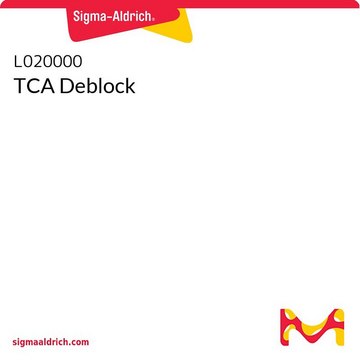707066
DCA Deblock (0.36M dichloroacetic acid in toluene)
Synonym(s):
DCA Deblock, DEBLOCK (0.36M dichloroacetic acid in toluene)
About This Item
Recommended Products
form
liquid
Quality Level
concentration
≤100 ppm in H2O
bp
110-111 °C
density
0.884 g/mL at 25 °C
SMILES string
OC(=O)C(Cl)Cl
InChI
1S/C2H2Cl2O2/c3-1(4)2(5)6/h1H,(H,5,6)
InChI key
JXTHNDFMNIQAHM-UHFFFAOYSA-N
Looking for similar products? Visit Product Comparison Guide
General description
Application
Signal Word
Danger
Hazard Statements
Precautionary Statements
Hazard Classifications
Aquatic Chronic 3 - Asp. Tox. 1 - Carc. 2 - Eye Dam. 1 - Flam. Liq. 2 - Lact. - Repr. 1B - Skin Irrit. 2 - STOT RE 2 Inhalation - STOT SE 3
Target Organs
Central nervous system
Storage Class Code
3 - Flammable liquids
WGK
WGK 3
Flash Point(F)
41.0 °F
Flash Point(C)
5 °C
Personal Protective Equipment
Regulatory Listings
Regulatory Listings are mainly provided for chemical products. Only limited information can be provided here for non-chemical products. No entry means none of the components are listed. It is the user’s obligation to ensure the safe and legal use of the product.
PRTR
Class I Designated Chemical Substances
FSL
Group 4: Flammable liquids
Type 1 petroleums
Hazardous rank II
Water insoluble liquid
ISHL Indicated Name
Substances Subject to be Indicated Names
ISHL Notified Names
Substances Subject to be Notified Names
JAN Code
707066-205L-P1-SB:
707066-4X4L:4548173998497
707066-BULK:
707066-50L-P2:
707066-200L-P1:
707066-VAR:
Choose from one of the most recent versions:
Already Own This Product?
Find documentation for the products that you have recently purchased in the Document Library.
Our team of scientists has experience in all areas of research including Life Science, Material Science, Chemical Synthesis, Chromatography, Analytical and many others.
Contact Technical Service











